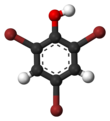2,4,6-Tribromophenol (TBP) is a brominated derivative of phenol. It is used as a fungicide, as a wood preservative, and an intermediate in the preparation of flame retardants.
| |||
| Names | |||
|---|---|---|---|
| Preferred IUPAC name
2,4,6-Tribromophenol | |||
| Other names
Tribromophenol; 2,4,6-TBP; TBP | |||
| Identifiers | |||
3D model (JSmol) |
|||
| ChEBI | |||
| ChEMBL | |||
| ChemSpider | |||
| DrugBank | |||
| ECHA InfoCard | 100.003.890 | ||
| KEGG | |||
PubChem CID |
|||
| UNII | |||
CompTox Dashboard (EPA) |
|||
| |||
| |||
| Properties | |||
| C6H3Br3O | |||
| Molar mass | 330.801 g·mol−1 | ||
| Appearance | White needles or prisms[1] | ||
| Melting point | 95.5 °C (203.9 °F; 368.6 K)[1] | ||
| Boiling point | 244 °C (471 °F; 517 K)[2] 286 °C[1] | ||
| Slightly soluble[1] 59-61 mg/L[3] | |||
| Hazards | |||
| GHS labelling: | |||
  [4] [4] | |||
| NFPA 704 (fire diamond) | |||
| Lethal dose or concentration (LD, LC): | |||
LD50 (median dose) |
2000 mg/kg (rat, oral)[1] | ||
Except where otherwise noted, data are given for materials in their standard state (at 25 °C [77 °F], 100 kPa).
| |||
Production
Although natural TBP has been identified in ocean sediments as a metabolite of marine fauna,[5] the commercial product is prepared industrially. In 2001, the production volume of TBP was estimated to be 2500 tonnes/year in Japan and 9500 tonnes/year worldwide.[3] TBP can be prepared by the controlled reaction of elemental bromine with phenol:[2]
Uses
The predominant use of TBP is as an intermediate in the preparation of flame retardants such as brominated epoxy resins.[3] TBP is reacted with sodium hydroxide to form the sodium salt, which is used as a fungicide and wood preservative.[6][7]
Bismuth salt
The bismuth salt is the active ingredient in Xeroform[clarification needed] dressing.[8]
Metabolism
Microbial metabolism in products treated with TBP is known to produce 2,4,6-tribromoanisole (TBA),[9] which has a musty odor. In 2010 and 2011, Pfizer and Johnson & Johnson voluntarily recalled some products due to TBA odors from wooden pallets which were treated with TBP.[10][11][12][13]
References
Wikiwand in your browser!
Seamless Wikipedia browsing. On steroids.
Every time you click a link to Wikipedia, Wiktionary or Wikiquote in your browser's search results, it will show the modern Wikiwand interface.
Wikiwand extension is a five stars, simple, with minimum permission required to keep your browsing private, safe and transparent.



